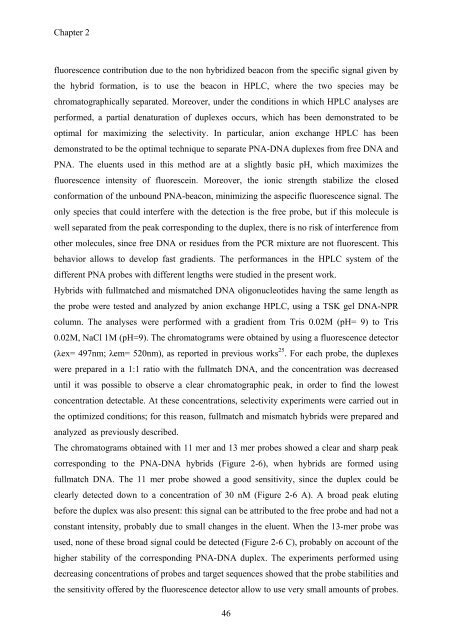View - DSpace UniPR
View - DSpace UniPR
View - DSpace UniPR
Create successful ePaper yourself
Turn your PDF publications into a flip-book with our unique Google optimized e-Paper software.
Chapter 2<br />
fluorescence contribution due to the non hybridized beacon from the specific signal given by<br />
the hybrid formation, is to use the beacon in HPLC, where the two species may be<br />
chromatographically separated. Moreover, under the conditions in which HPLC analyses are<br />
performed, a partial denaturation of duplexes occurs, which has been demonstrated to be<br />
optimal for maximizing the selectivity. In particular, anion exchange HPLC has been<br />
demonstrated to be the optimal technique to separate PNA-DNA duplexes from free DNA and<br />
PNA. The eluents used in this method are at a slightly basic pH, which maximizes the<br />
fluorescence intensity of fluorescein. Moreover, the ionic strength stabilize the closed<br />
conformation of the unbound PNA-beacon, minimizing the aspecific fluorescence signal. The<br />
only species that could interfere with the detection is the free probe, but if this molecule is<br />
well separated from the peak corresponding to the duplex, there is no risk of interference from<br />
other molecules, since free DNA or residues from the PCR mixture are not fluorescent. This<br />
behavior allows to develop fast gradients. The performances in the HPLC system of the<br />
different PNA probes with different lengths were studied in the present work.<br />
Hybrids with fullmatched and mismatched DNA oligonucleotides having the same length as<br />
the probe were tested and analyzed by anion exchange HPLC, using a TSK gel DNA-NPR<br />
column. The analyses were performed with a gradient from Tris 0.02M (pH= 9) to Tris<br />
0.02M, NaCl 1M (pH=9). The chromatograms were obtained by using a fluorescence detector<br />
(λex= 497nm; λem= 520nm), as reported in previous works 25 . For each probe, the duplexes<br />
were prepared in a 1:1 ratio with the fullmatch DNA, and the concentration was decreased<br />
until it was possible to observe a clear chromatographic peak, in order to find the lowest<br />
concentration detectable. At these concentrations, selectivity experiments were carried out in<br />
the optimized conditions; for this reason, fullmatch and mismatch hybrids were prepared and<br />
analyzed as previously described.<br />
The chromatograms obtained with 11 mer and 13 mer probes showed a clear and sharp peak<br />
corresponding to the PNA-DNA hybrids (Figure 2-6), when hybrids are formed using<br />
fullmatch DNA. The 11 mer probe showed a good sensitivity, since the duplex could be<br />
clearly detected down to a concentration of 30 nM (Figure 2-6 A). A broad peak eluting<br />
before the duplex was also present: this signal can be attributed to the free probe and had not a<br />
constant intensity, probably due to small changes in the eluent. When the 13-mer probe was<br />
used, none of these broad signal could be detected (Figure 2-6 C), probably on account of the<br />
higher stability of the corresponding PNA-DNA duplex. The experiments performed using<br />
decreasing concentrations of probes and target sequences showed that the probe stabilities and<br />
the sensitivity offered by the fluorescence detector allow to use very small amounts of probes.<br />
46
















